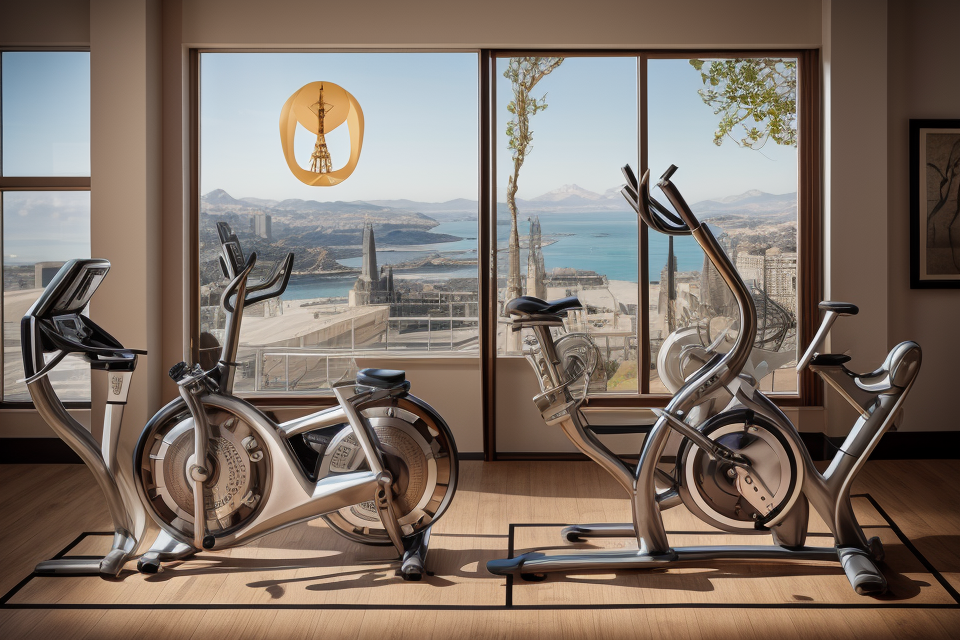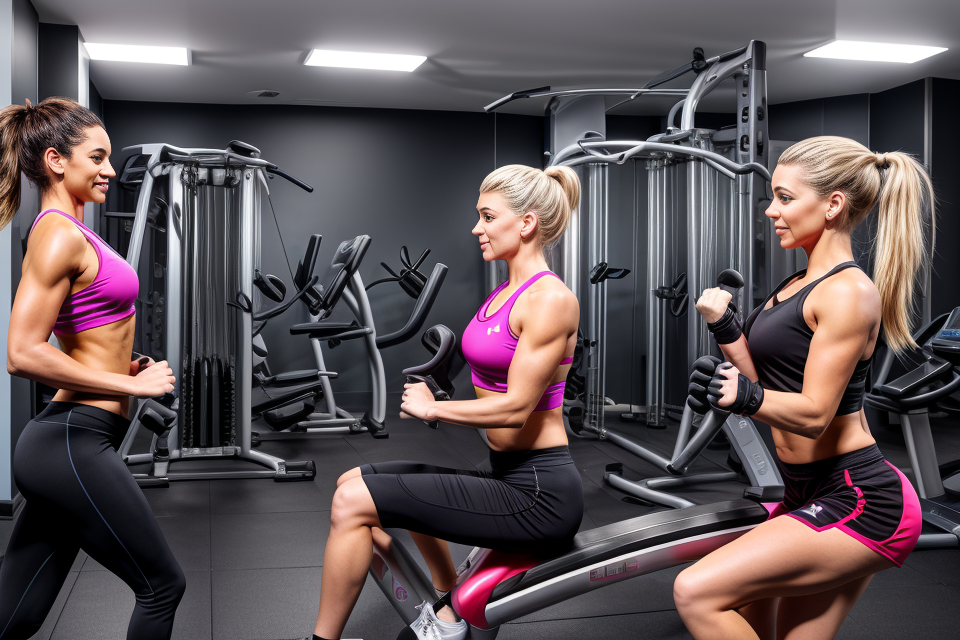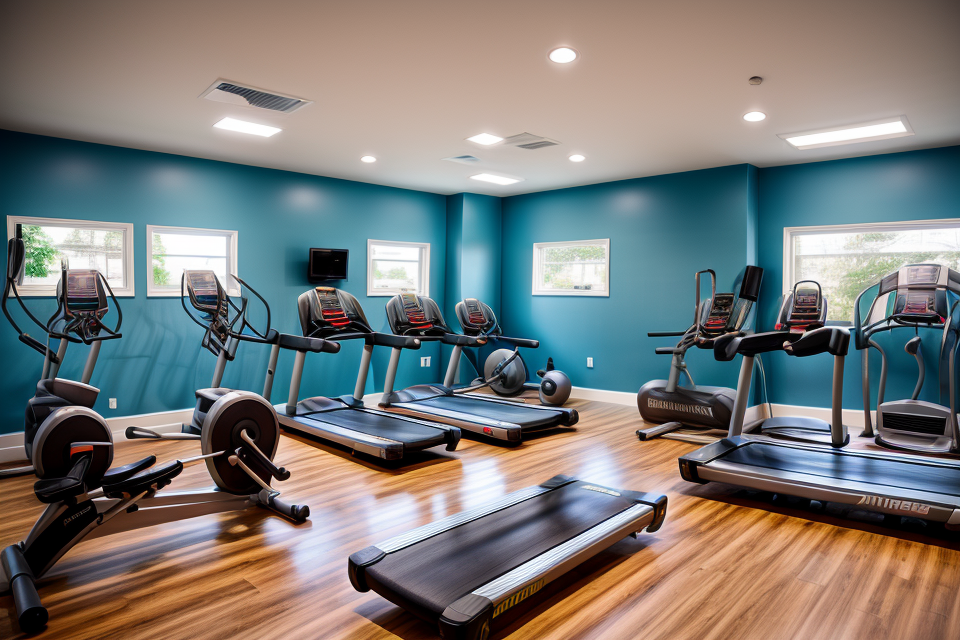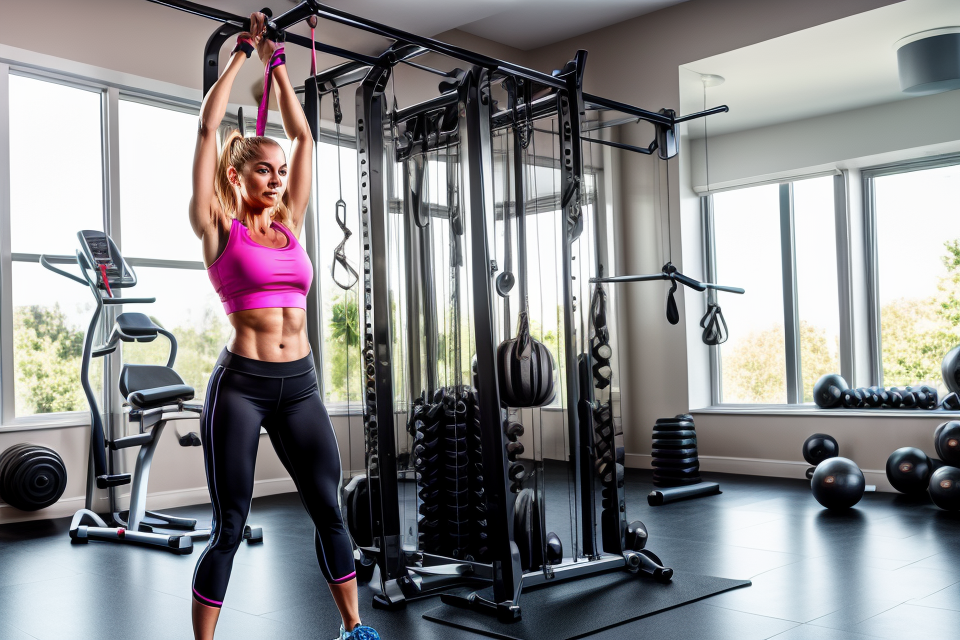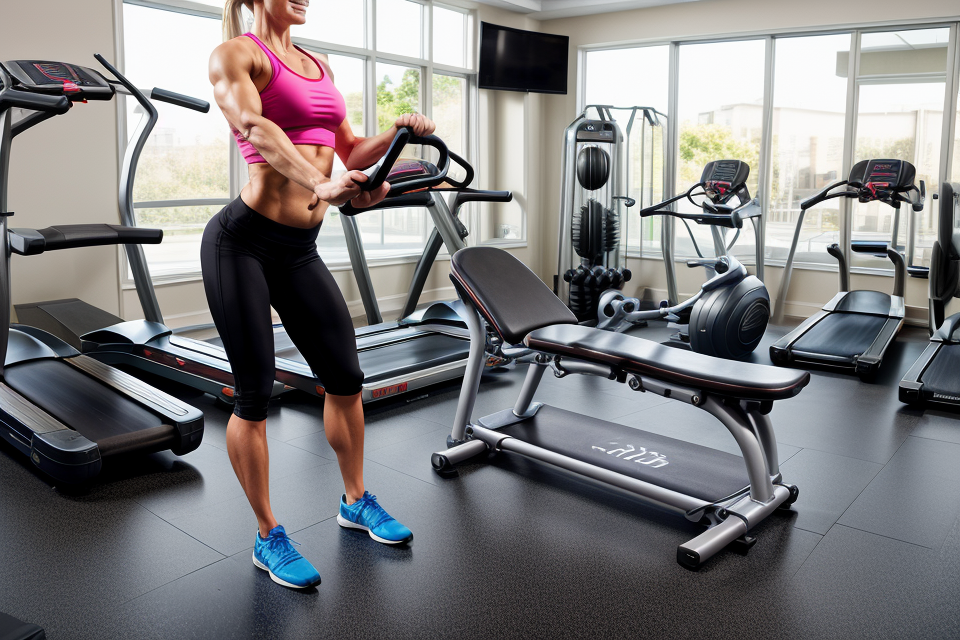The quest for physical fitness has been a part of human history since ancient times. People have always been searching for ways to improve their physical health and stay in shape. As technology has advanced, so has the equipment used to achieve this goal. From ancient weights made of stone and metal to modern machines with digital displays, the history of fitness equipment is a fascinating journey through time. In this article, we will explore the oldest exercise equipment and how it has evolved over the years. Get ready to discover the exciting world of fitness equipment and how it has transformed over time.
The Evolution of Fitness Equipment
The Origins of Fitness Equipment
Early humans and their natural fitness routines
Humans have always had a natural inclination towards physical activity. In ancient times, our ancestors were constantly on the move, engaging in activities such as hunting, gathering, and farming. These activities required strength, endurance, and agility, and they helped to build strong bodies and minds.
The role of physical activity in ancient civilizations
Physical activity played a significant role in ancient civilizations. In ancient Greece, for example, athletics were highly valued, and sports such as running, wrestling, and boxing were popular. These sports were not just for entertainment but also for health and fitness purposes. Similarly, in ancient China, martial arts were developed as a form of exercise and self-defense.
The development of sports and competition
As civilizations grew and developed, so did the variety of sports and competitions. In medieval Europe, for example, jousting and archery were popular, while in India, traditional sports such as kabaddi and gilli-danda were played. These sports helped to develop physical fitness and were often used to train soldiers and warriors.
Over time, sports and physical activity became more organized and widespread, leading to the development of specialized equipment and training methods. The evolution of fitness equipment has been a reflection of our changing attitudes towards health and fitness, and it continues to evolve as new technologies and ideas are developed.
Medieval and Renaissance Fitness Equipment
During the medieval and renaissance periods, fitness equipment was not as advanced as it is today. However, people still engaged in physical activities that helped them stay fit and healthy. Here are some examples of fitness equipment used during these times:
- Monastic fitness routines: Monks and nuns engaged in physical activities as part of their daily routine. They performed exercises such as push-ups, sit-ups, and squats, and also participated in sports like tennis and archery. These activities helped them maintain their physical fitness and also improved their overall health.
- Weighted tools and implements for strength training: People used weighted tools and implements for strength training during this period. For example, farmers used heavy tools such as plows and hoes to work on their farms, which helped them build strength in their arms and legs. Blacksmiths also used heavy hammers and anvils to forge metal, which improved their grip strength and overall physical fitness.
- Martial arts and self-defense equipment: During the medieval and renaissance periods, martial arts and self-defense were essential skills for many people. Warriors and knights used weapons such as swords, shields, and lances to train for battle. They also engaged in hand-to-hand combat using techniques such as wrestling and fencing. This physical activity helped them maintain their fitness and prepared them for battle.
Overall, the fitness equipment used during the medieval and renaissance periods was simple but effective. People engaged in physical activities that helped them maintain their fitness and improve their overall health. These activities formed the foundation for modern fitness equipment and workout routines.
The Industrial Revolution and Fitness Equipment
- The invention of the gym
- The rise of fitness clubs and personal trainers
- The introduction of specialized equipment for specific exercises
During the Industrial Revolution, the concept of fitness equipment began to evolve rapidly. With the growth of factories and urbanization, people began to realize the importance of physical activity for maintaining good health. This led to the invention of the first gym, which was designed to provide a space for people to exercise and stay fit.
The gym was initially a luxury that only the wealthy could afford, but as time passed, it became more accessible to the general public. Fitness clubs began to pop up in cities across the world, offering a variety of equipment and classes for people to choose from.
Personal trainers also became more popular during this time, as people sought out professional guidance and motivation to achieve their fitness goals. The rise of personal training allowed for more customized workout plans and increased the effectiveness of exercise routines.
As the popularity of fitness clubs and personal training grew, so did the demand for specialized equipment. Manufacturers began to design machines specifically for certain exercises, such as weightlifting and cardio. This led to the introduction of machines like the treadmill and the elliptical, which are now staples in most gyms today.
Overall, the Industrial Revolution played a significant role in the evolution of fitness equipment. It paved the way for the creation of gyms, fitness clubs, and personal trainers, and led to the development of specialized equipment that has made exercise more effective and accessible to people all over the world.
Types of Fitness Equipment
Cardiovascular Machines
Treadmills
Treadmills have been used for fitness purposes since the late 1800s. They were originally designed as a means of providing a workout for soldiers during the off-season. Over time, treadmills have evolved to become more sophisticated and offer a wider range of features. Modern treadmills come equipped with heart rate monitors, personal trainers, and incline adjustments to provide a more effective workout.
Stationary Bikes
Stationary bikes, also known as exercise bikes, have been used for fitness since the mid-1800s. They were originally designed as a means of providing a low-impact workout for people with joint or back problems. Today, stationary bikes come in a variety of styles, including recumbent bikes and spin bikes, and offer features such as adjustable resistance and heart rate monitoring.
Rowing Machines
Rowing machines have been used for fitness since the late 1800s. They were originally designed as a means of providing a full-body workout that was easy on the joints. Today, rowing machines come in a variety of styles, including hydraulic rowing machines and magnetic rowing machines, and offer features such as adjustable resistance and heart rate monitoring.
Elliptical Trainers
Elliptical trainers have been used for fitness since the 1990s. They were originally designed as a low-impact alternative to treadmills and offer a full-body workout that is easy on the joints. Today, elliptical trainers come in a variety of styles, including front-drive and rear-drive machines, and offer features such as adjustable resistance and heart rate monitoring.
Strength Training Equipment
- Dumbbells
Dumbbells are one of the oldest forms of strength training equipment. They are weights that can be lifted to build muscle strength and endurance. They come in various sizes and weights, making them suitable for people of all fitness levels. - Barbells
Barbells are similar to dumbbells, but they have a bar that runs through the center of the weights. This allows for more weight to be lifted, making them ideal for advanced weightlifters. - Kettlebells
Kettlebells are weights with a handle on the top. They are designed to be swung in a circular motion, making them a popular choice for strength training and cardio workouts. - Medicine balls
Medicine balls are weighted balls that are used to improve strength, balance, and coordination. They can be thrown, caught, and rolled, making them a versatile tool for strength training. - Resistance bands
Resistance bands are long, stretchy bands made of rubber or silicone. They are used to provide resistance during exercises, making them ideal for people who want to work out at home or while traveling. They come in various resistance levels, making them suitable for people of all fitness levels.
Bodyweight Training Equipment
Bodyweight training equipment has been a staple in fitness for centuries, long before the invention of modern gym machines. These simple tools are designed to help individuals improve their strength, flexibility, and overall fitness level without the need for expensive equipment. Here are some examples of bodyweight training equipment:
- Pull-up bars: Pull-up bars are a classic example of bodyweight training equipment. They have been used for decades to help individuals build upper body strength and improve their grip strength. Pull-up bars can be found in most gyms and are also relatively inexpensive to purchase for home use.
- Parallel bars: Parallel bars are another classic bodyweight training tool. They are designed to help individuals improve their grip strength, balance, and core stability. Parallel bars are typically found in gyms, but they can also be easily made at home using two parallel bars or other sturdy objects.
- Dipping bars: Dipping bars are used to help individuals build strength in their shoulders, triceps, and chest. They can be found in most gyms and are relatively inexpensive to purchase for home use.
- Squat racks: Squat racks are designed to help individuals safely perform squats, which are one of the most effective exercises for building lower body strength and muscle mass. Squat racks can be found in most gyms and are also available for purchase for home use.
- Climbing ropes: Climbing ropes are used to help individuals build grip strength, upper body strength, and core stability. They can be found in most gyms and are also available for purchase for home use.
Overall, bodyweight training equipment is a great option for individuals who want to improve their fitness level without the need for expensive gym machines. These simple tools can be used to build strength, improve flexibility, and increase overall fitness level, making them a valuable addition to any workout routine.
Functional Fitness Equipment
Functional fitness equipment refers to exercise tools that target multiple muscle groups and aim to improve overall physical fitness. This type of equipment often requires little to no technical knowledge and can be used in various settings, from personal training studios to home gyms. Here are some examples of functional fitness equipment:
- Jump ropes: A classic piece of fitness equipment, jump ropes have been used for decades to improve cardiovascular health, coordination, and agility. They are affordable, portable, and can be used by people of all ages and fitness levels.
- Plyometric boxes: These boxes are designed to help athletes improve their power, speed, and explosiveness. They are often used in plyometric training, which involves jumping and landing from heights to build strength and explosiveness in the legs and lower body.
- Agility ladders: Agility ladders are versatile training tools that can be used to improve coordination, balance, and footwork. They are often used in sports-specific training, such as football, soccer, and basketball, to help athletes improve their speed and agility.
- Kettlebell swings: Kettlebell swings are a popular exercise that engages multiple muscle groups, including the glutes, hamstrings, and lower back. They are an effective way to build strength, endurance, and overall physical fitness.
- Sandbags: Sandbags are a simple yet effective piece of functional fitness equipment. They can be filled with sand or other materials to provide resistance during exercises, making them a versatile tool for improving strength and conditioning.
Mind-Body Fitness Equipment
Yoga mats
Yoga mats are a type of mind-body fitness equipment that have been around for several decades. They are designed to provide a non-slip surface for individuals to practice yoga poses and exercises. Yoga mats were originally made from rubber, but they are now commonly made from materials such as PVC, TPE, and EVA. The modern yoga mat typically features a texture that provides good grip and cushioning, which helps to reduce the impact of poses and improve overall comfort during practice.
Pilates reformers
Pilates reformers are another type of mind-body fitness equipment that have been around for several decades. They were invented by Joseph Pilates in the early 20th century and have since become a popular tool for physical fitness. Pilates reformers are designed to provide support and resistance during exercise, and they can be used to perform a wide range of movements and exercises. They typically consist of a bed, a frame, and a set of adjustable foot bar and handholds, which can be moved to create different levels of resistance.
Tai chi swords
Tai chi swords are a type of mind-body fitness equipment that have been used for centuries in traditional Chinese martial arts. They are typically made of metal and are designed to be lightweight and balanced, allowing for smooth and fluid movements. Tai chi swords are often used in conjunction with other equipment, such as push hands (a type of martial arts training dummy), to help improve balance, coordination, and overall physical fitness.
Meditation cushions
Meditation cushions are a type of mind-body fitness equipment that have become increasingly popular in recent years. They are designed to provide support and comfort during meditation, helping to reduce the risk of discomfort or injury. Meditation cushions come in a variety of sizes and shapes, and they are typically made of materials such as foam, buckwheat, or kapok. Some meditation cushions are designed to be portable, making them easy to take on the go.
Balance boards
Balance boards are a type of mind-body fitness equipment that are designed to improve balance and stability. They typically consist of a board with a flat surface and a set of rollers or wheels, which allow the board to move in different directions. Balance boards can be used to perform a variety of exercises, such as standing on one leg or walking in a straight line. They are often used by athletes and fitness enthusiasts to improve proprioception and stability, which can help prevent injuries and improve overall performance.
Innovations in Fitness Equipment
Smart Fitness Equipment
Smart fitness equipment has revolutionized the way people exercise by providing a more personalized and engaging workout experience. These connected machines not only track progress but also offer workout suggestions and insights, making it easier for individuals to reach their fitness goals. Here are some examples of smart fitness equipment:
- Connected Machines:
- Cardio equipment such as treadmills, stationary bikes, and ellipticals are now equipped with sensors that track distance, pace, heart rate, and calories burned. This data can be synced with a smartphone or a fitness app, allowing users to monitor their progress and receive feedback on their performance.
- Strength training equipment such as weight machines and resistance bands can also be connected to smart devices. These machines can adjust the resistance level based on the user’s strength and provide real-time feedback on form and technique.
- Virtual Reality and Augmented Reality Fitness Experiences:
- Virtual reality (VR) and augmented reality (AR) technology have enabled users to experience a more immersive and engaging workout. VR headsets can transport users to a virtual gym, where they can participate in a variety of workouts, from yoga to boxing. AR technology can overlay virtual objects onto the real world, providing users with visual cues and feedback during their workout.
- Wearable Technology:
- Wearable technology such as smartwatches and fitness trackers have become increasingly popular for monitoring and tracking fitness levels. These devices can track steps, heart rate, and sleep patterns, providing users with insights into their daily activity levels. Some wearables even offer personalized workout suggestions based on the user’s fitness goals and progress.
Overall, smart fitness equipment has transformed the fitness industry by providing users with a more personalized and engaging workout experience. With the continued advancement of technology, it is likely that we will see even more innovative smart fitness equipment in the future.
Environmentally Friendly Fitness Equipment
- Recycled materials and sustainable manufacturing processes
- In recent years, there has been a growing trend towards using recycled materials in fitness equipment. This not only reduces waste and conserves natural resources, but also helps to lower the carbon footprint of the manufacturing process.
- Many companies now prioritize sustainable manufacturing practices, such as reducing energy consumption and minimizing water usage, in order to create a more environmentally friendly product.
- Products designed for outdoor use and natural environments
- Outdoor fitness equipment, such as exercise stations and trails, are becoming increasingly popular as people seek to get in shape while enjoying the great outdoors.
- These products are often made from durable materials that can withstand the elements, and are designed to blend in with their surroundings in order to minimize their impact on the environment.
- Fitness equipment made from eco-friendly materials
- Some companies are now using innovative materials, such as bamboo and bioplastics, to create fitness equipment that is both environmentally friendly and functional.
- These materials are renewable and require less energy to produce than traditional materials, making them a more sustainable choice for fitness enthusiasts who are conscious of their environmental impact.
The Future of Fitness Equipment
Predictions for the Next Decade
Further integration of technology into fitness equipment
As technology continues to advance, it is likely that we will see even more integration of digital tools into our workout routines. This could include everything from wearable fitness trackers that monitor our progress and provide real-time feedback, to virtual reality systems that allow us to exercise in immersive environments. By combining the latest in technology with the latest in fitness science, we can create more effective and engaging workouts that help us achieve our goals faster and more efficiently.
Increased focus on personalized workouts and virtual training
Another trend that is likely to continue to grow in the coming years is the focus on personalized workouts and virtual training. With the help of artificial intelligence and machine learning algorithms, fitness equipment will become even better at tailoring workouts to our individual needs and goals. This could include everything from customized exercise programs that are based on our personal fitness data, to virtual trainers who provide real-time feedback and coaching. By making our workouts more personalized and tailored to our specific needs, we can get better results and stay motivated to achieve our goals.
The rise of smart homes and connected fitness experiences
Finally, as smart home technology continues to evolve, we can expect to see more connected fitness experiences that seamlessly integrate with our daily routines. This could include everything from smart gym equipment that syncs with our smart home devices, to virtual fitness classes that we can attend from the comfort of our own homes. By creating a more seamless and connected fitness experience, we can make it easier to stay motivated and committed to our fitness goals, even when we are short on time or don’t have access to a traditional gym.
Emerging Trends in Fitness Equipment
As technology continues to advance, so too does the world of fitness equipment. Here are some of the emerging trends that are shaping the future of fitness equipment:
Kinetic and Dynamic Resistance Training
One of the biggest trends in fitness equipment is the use of kinetic and dynamic resistance training. This type of training involves the use of movement-based exercises that are designed to increase muscle strength and flexibility.
Kinetic and dynamic resistance training is different from traditional resistance training, which typically involves lifting weights or using resistance bands. With kinetic and dynamic resistance training, the body becomes the resistance, making it a more effective way to build strength and improve overall fitness.
Fitness Equipment Designed for Small Spaces
Another trend in fitness equipment is the development of equipment that is designed for small spaces. With the rise of micro-homes and smaller living spaces, it can be difficult to find room for bulky fitness equipment.
To address this issue, manufacturers are developing smaller, more compact fitness equipment that can be easily stored and used in even the smallest of spaces. This includes items like foldable treadmills, space-saving weight benches, and compact ellipticals.
Innovative Materials and Designs for Enhanced Performance and Safety
Finally, there is a growing trend towards the use of innovative materials and designs in fitness equipment. This includes the use of new materials like carbon fiber and kevlar, which are lighter and stronger than traditional materials like steel and aluminum.
In addition, manufacturers are incorporating new technologies like sensors and smart devices into their equipment to enhance performance and safety. For example, some treadmills now come with built-in heart rate monitors, while other equipment includes safety sensors that automatically stop the machine if it detects an unsafe movement.
Overall, these emerging trends in fitness equipment are shaping the future of the industry, making it easier for people to stay fit and healthy no matter where they live or how much space they have.
FAQs
1. What is the oldest known form of exercise equipment?
The oldest known form of exercise equipment is believed to be the Greek gymnasium. The Greek gymnasium was a place where individuals would go to exercise and participate in physical activities. It was a large facility that contained various types of equipment, including weights, bars, and horseshoe-shaped tracks. The gymnasium was used for strength training, running, and other forms of exercise. The equipment used in the gymnasium was made from materials such as wood, stone, and metal.
2. When was the first weightlifting machine invented?
The first weightlifting machine was invented in the late 1800s by a man named Thomas Inch. Inch was a British strongman who developed a device that he called the “Inch Dumbbell.” The Inch Dumbbell was a simple piece of equipment that consisted of a metal handle and a metal rod. The rod was weighted at one end, and the handle was used to lift the weight. The Inch Dumbbell was the first piece of equipment designed specifically for weightlifting, and it paved the way for the development of other weightlifting machines.
3. What was the first piece of cardiovascular exercise equipment?
The first piece of cardiovascular exercise equipment was the mechanical horse. The mechanical horse was invented in the early 1900s by a man named George Washington Shuster. Shuster was a physician who was interested in the benefits of exercise for his patients. He developed the mechanical horse as a way to provide a safe and effective form of exercise for his patients. The mechanical horse was a simple device that consisted of a metal frame with a moving platform. It was operated by a lever, and riders could adjust the speed of the platform by adjusting the lever. The mechanical horse was the first piece of cardiovascular exercise equipment, and it paved the way for the development of other cardio machines such as treadmills and stationary bikes.
4. Who invented the first treadmill?
The first treadmill was invented in the late 1800s by a man named William H. Wood. Wood was an Englishman who lived in London. He was interested in the benefits of exercise for the working class, and he developed the treadmill as a way to provide a safe and effective form of exercise for factory workers. The treadmill was a simple device that consisted of a moving belt that people could walk or run on. The speed of the belt could be adjusted, and the treadmill was powered by a motor. The treadmill was the first piece of cardiovascular exercise equipment to be used in a commercial setting, and it paved the way for the development of other cardio machines such as stationary bikes and rowing machines.
5. When was the first exercise bike invented?
The first exercise bike was invented in the late 1800s by a man named George B. Sutherland. Sutherland was a British physician who was interested in the benefits of exercise for his patients. He developed the exercise bike as a way to provide a safe and effective form of exercise for his patients. The exercise bike was a simple device that consisted of a metal frame with a pedal mechanism. It was operated by a lever, and riders could adjust the resistance of the pedals by adjusting the lever. The exercise bike was the first piece of cardiovascular exercise equipment to be used in a home setting, and it paved the way for the development of other cardio machines such as ellipticals and stair steppers.






